
Nothing compares to the simple pleasure of a bike ride. J.F.Kennedy
Search this website
Argentina's Lake District
Zapala, La Amarga, Junín de los Andes, San Martín de los Andes, Pichi Traful, Villa La Angostura, San Carlos de Bariloche, Puerto Paòuelo, Bahía López, Colonia Suiza, Bariloche
Zapala
When arriving in Zapala in the evening, I considered whether it was better to camp out somewhere on the outskirts to save on accommodation. Had the following day been a working day, sleeping in the wilds would clearly have won. But it was to be a Saturday, and small city stores usually only open until 13:00 and I had an urgent need to wash my clothes.
It was a good decision. In the evening, I firstly checked my e-mail and the news. The truth is that, if one does not have time for something, one finds that you in fact do not care about it. Even then, I went to bed after midnight at 01:00.
Straight after a poor hotel breakfast, I dragged my bag of dirty clothes to the only laundry near the city center. The price was high. It was 130 pesos for 2.5 kg of laundry. Usually the price was 50-60 pesos. The washing would be ready by midday, they would close at 13:00 and open again on Monday. I shopped in a supermarket, where my Visa card was not accepted and then went to purchase a gas canister for my stove. It was only available at one store and at 140 pesos. Once again, daylight robbery! But I had no option.
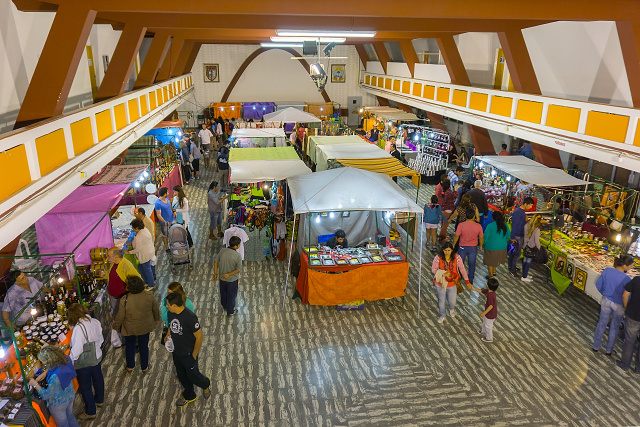
Zampala: Local artists' fair, the largest event of the past quarter
As I had to pay cash for my accommodation, I had reached the bottom of my cash reserves. I had about 140 pesos left. I would not even get a decent meal for that. I went to all six local bank ATMs and was refused each time with a message that I had entered an incorrect amount for withdrawal. Even when entering a lower amount than my usual 1000 pesos, the message was the same. Perhaps entering a minus amount would work, but that was not an option.
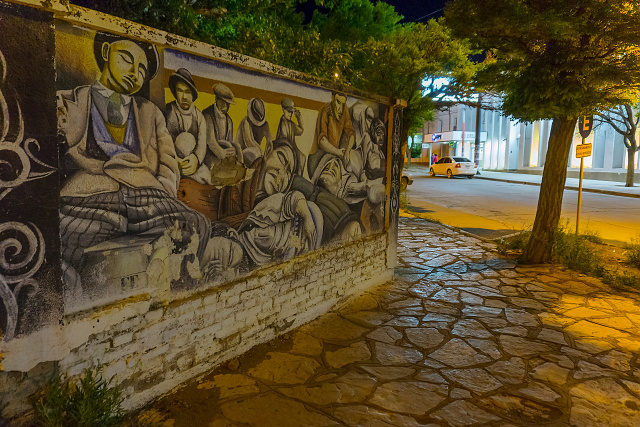
Zampala: Murals in the center
Simply said, I was in dire straits. My card did not work in the supermarket or in ATMs, not even in the otherwise reliable Nacional Bank. So I walked around, searching for an ATM which I had not yet tried. I noticed a small Exchange office. They were cleaning, as it was 13:15 and they had closed at 13:00. I asked about their exchange rate, which turned out to be very favorable: 12 pesos to 1 USD. I said I had my dollars in the hotel, and the girl at the counter said she would wait. She did wait and in 10 minutes I had 1440 pesos in my hands for my 120 USD. That was a good deal. Moreover, I had bought those dollars a long time before at the rate of CZK 16.
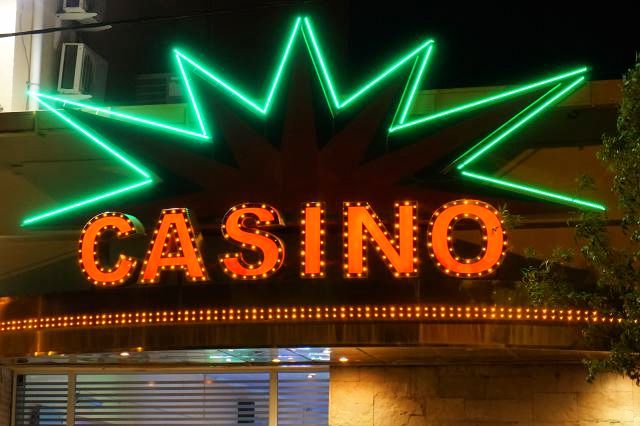
Zampala: A casino can be found literally in every corner of Argentina
My financial crisis was resolved and, thanks to my newly gained self-confidence, I stopped once again at the Nacional Bank. They had three ATMs. One only for their clients, I did not even try that one. Out of the other two, the one on the right had been out of order before, but then functioned when I later returned. Contrary to the dull machine on the left, it gave me those obbligato 1000 pesos. My wallet puffed up and I was once again a proud and fully fledged inhabitant of this planet.
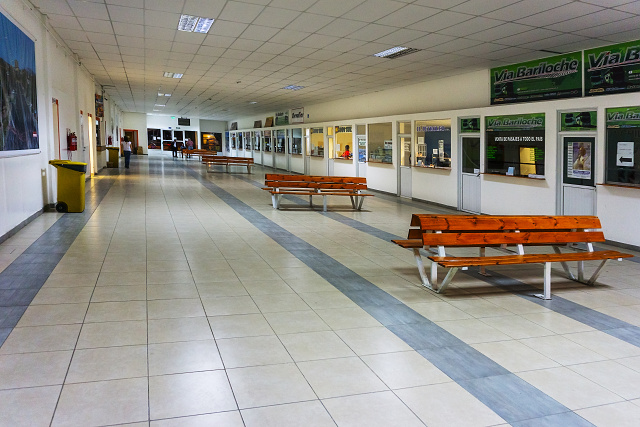
Zampala: Aseptically clean bus station

Zampala: Unusually well-groomed shop window of one of the clothing and fashion accessory stores
Writing a blog while traveling is sometimes an unbearable task. It took me till 01:30 in the morning to write down all my wisdom and upload it. I did not even have time to read it after uploading. I would fix it when I get back home.
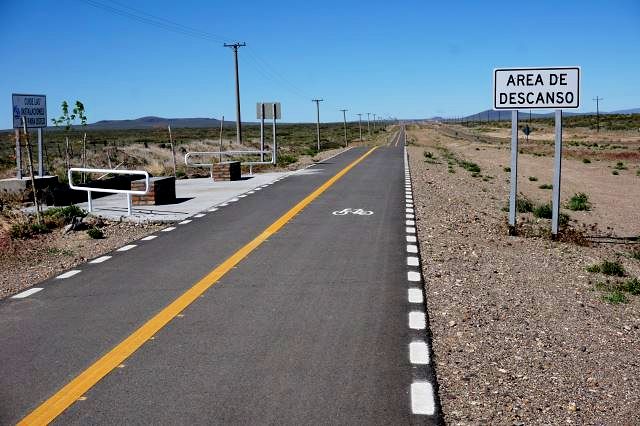
Zampala: Excellent 10-km long cycle path
Due to the two sleepless nights and possibly also a higher consumption, cycling did not go so well. A strong wind was blowing from 2 o'clock, which eliminated the advantage of the quality surface of the 10-km long cycle path. I battled against the strong wind blowing from 2 to 4 o'clock. Sometimes it was doable, sometimes not. I tried to convince the road to turn left, but it did not.
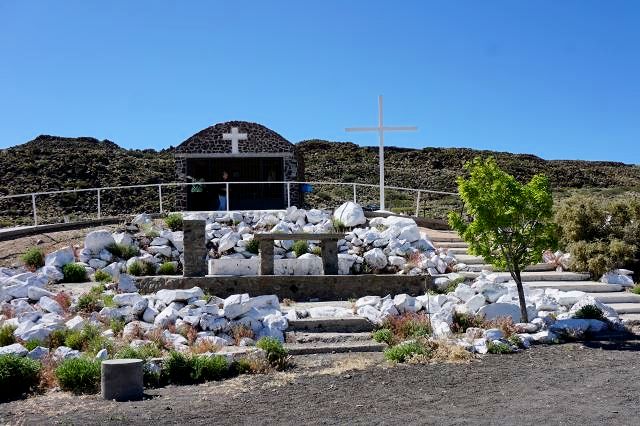
La Manzano: Chapel of La Virgen del Manzano

La Manzano: Statue of La Virgen del Manzano
Nevertheless, some events were more pleasant. Three young men aged about 20 years overtook me in a dilapidated Fiat Uno. They gave me a chilled, 1.5-liter bottle of Pepsi. We talked for a bit and then they turned their car around and left. They had seen me cycling past their solitary house and decided to fortify me. Amazing, also considering their young age and that they were evidently not so well off.
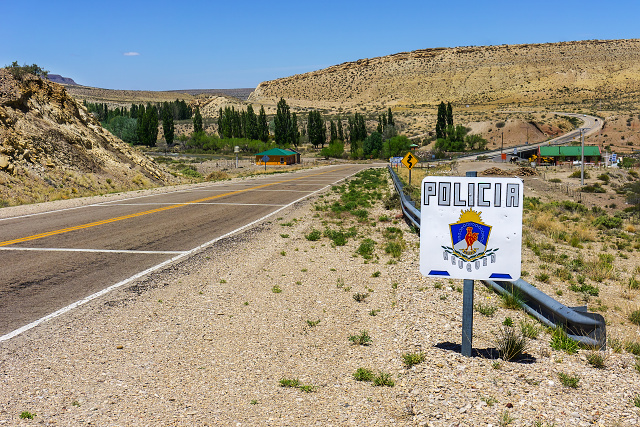
Puente Picún Leufú: Police check points are common in Argentina
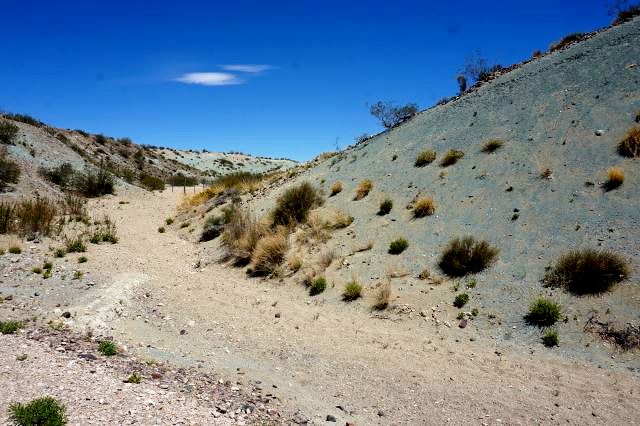
Near Puente Picún Leufú: Bluish hills
Close to Las Cortaderas the real party started! The wind got stronger, reaching the level of a Czech storm. It attacked me from the right and its unpredictability pushed me into the roadway. Luckily there was not much traffic. Nevertheless, I could have been so unlucky as to have been pushed under the wheels of a truck. I did not feel safe and sought a solution. I could not give up and pitch my tent instead, as it would have been impossible in such a storm anyway. I disliked the idea of pushing the bicycle. Finally I figured it out. I cycled on the left side of the road and the wind sometimes pushed me into the rough verge. There I could, in the worst scenario, graze my skin, but I was not at risk of being hit by a car.
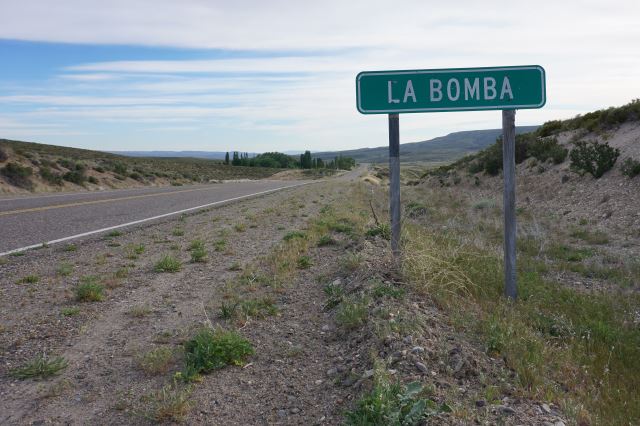
La Bomba: Pretentious name, but only one dilapidated hut in sight
Even then I suffered. I did not even complete 100 km, before camping out behind some tall bushes beside the road, which protected me slightly from the wind. The ground was dry and very dusty. Luckily there were many cardboard boxes lying around and I could use them to cover the ground and pitch my tent on them.
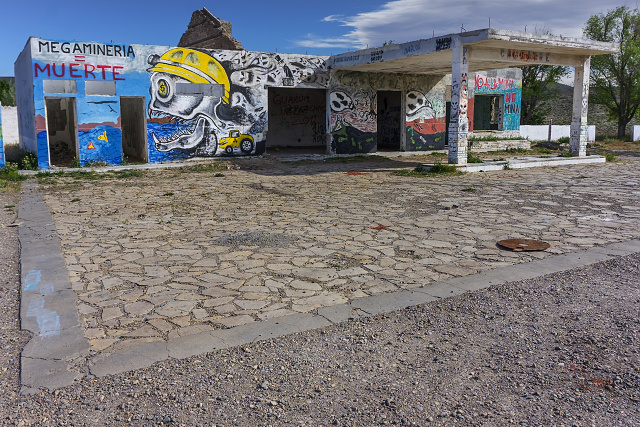
Near Catan Lil: Dilapidated, abandoned gas station
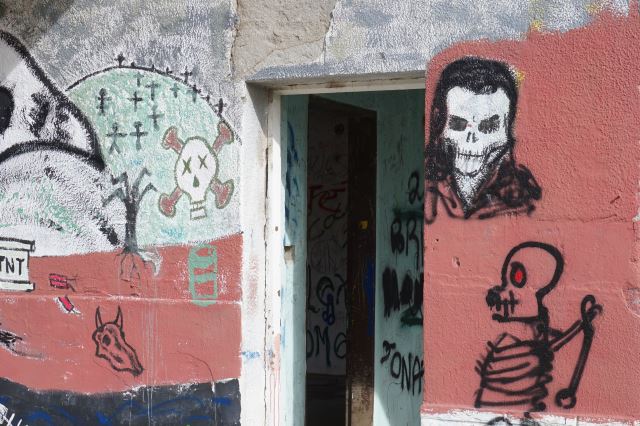
Near Catan Lil: Dilapidated, abandoned gas station - detail
I headed off at 07:00 without breakfast, in order to use the time when it was not yet blowing so hard. After 30 km, I came across a half-ruined gas station, with a handy walkway where I could eat my breakfast. After taking my first bite, a heavily laden French cyclist named Julien arrived. He had been on the road for more than five months and had cycled 9000 km (which is the same as my average 2000 km per month). The greatest oddity was that he was cycling in flip-flops. I had not seen that before. He was happy with that as he did not need to wash any socks.
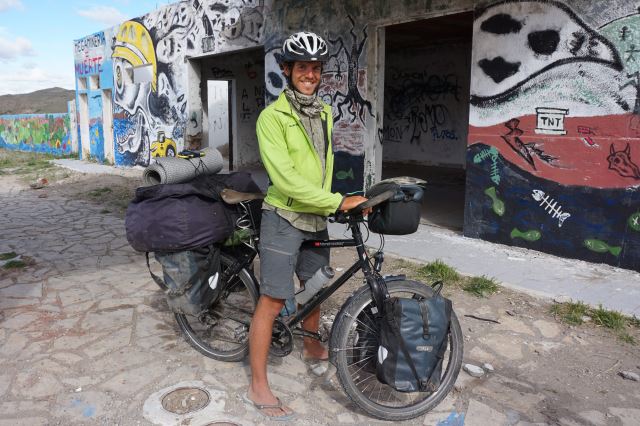
Near Catan Lil: French cyclist Julian cycling in the opposite direction, has traveled nearly 9000 km
Meanwhile a police patrol arrived and, after Julien had left, they came to shake hands and greet me. Satisfied by my breakfast, full of optimism, I continued my journey. Nevertheless, that was the end of the pleasant experiences.

Near Catan Lil: My Police amigos - the one on the right was more enlightened, as I let the public light pole grow from his head
It got dark, as if a storm was approaching. However, the cause of this was the disproportionately (by our standards) strong wind, blowing up the dust and there was no protection against it. I cycled with hooded eyes, but the next time I would take along welding goggles.
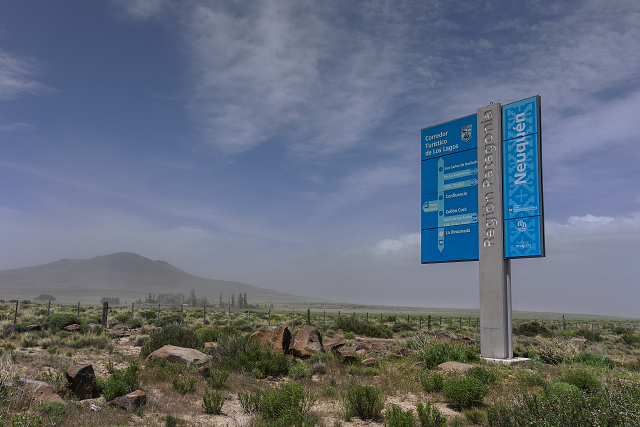
Near San Ignacio: Tourist signboard

La Rinconada: A narrow bridge over Rio Collon Cura
Horror, horror, how tall you are!
This Czech phrase, wittily used by Ivan Vyskoèil or Jan Vodòanský, literally meaning “Horror, horror, how tall you are!“ is a wordplay building on the similarity between Czech word „horo“ (mountain) and „horror“. Needless to say, it described my situation exactly. I was worried about my 30-km long route from La Rinconada to Junín. According to the map, the road would turn westward to lead straight into the wind.
I can truthfully say that I have never experienced such a strong, aggressive and insidious wind in my entire lifetime. The gale kept forcing me into the roadway and, in addition, the first 12 km were steeply uphill. Visibility was minimal due to the stirred up dust which got into my eyes and ground between my teeth. One km before the highest point, I pushed the bicycle. It was not a matter of not being able to cycle all the way up, but of safety. Vehicles could only see me from less than 50 meters away. With a strong gust of wind, I could have ended up under their wheels. I had never experienced this before. It was a matter of survival. I did not dare to take out the camera, it was not sealed against dust and could be seriously damaged in the storm.
I cycled those aforementioned 30 km in over 3 hours. Even on a steep downhill, I had to pedal in low gear to push through the furious wind. The wind was only muted by the surrounding trees down in the valley.
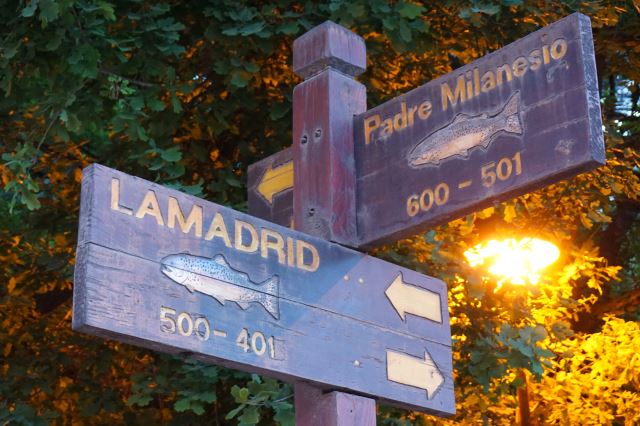
Junín de los Andes: Street signs
Originally I had wanted to cycle to a campsite, but it started raining and I felt very cold. Excited by the battle with the wind, I did not put on my jacket and stayed in my shorts with bare knees all the way. I ended up in a cheap, but clean and pleasant, hospedaje beside Road 40 in Junín center. I stocked up on food supplies in the nearby supermarket, cooked spaghetti, checked out the city – there was all in all nothing interesting to see. I kept waking up during the night, the memory of the struggle through the mountain storm repeating itself in my mind.
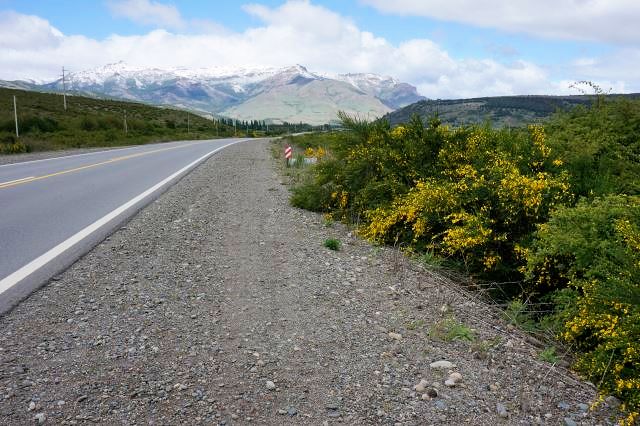
Road 40 km 2230: Flowering shrubs contrasting with snow-capped mountains
I was not in a hurry in the morning. I used the WiFi to answer my e-mails. I almost stopped checking the websites with news, it was always the same. Just like the weather, when I had to cycle against a strong wind. Before San Martín de los Andes, the road dived into a valley which protected me a little from the wind so I enjoyed it for about 10 km.
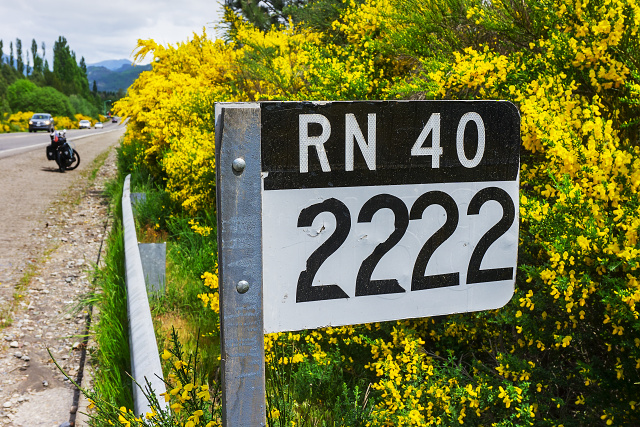
Road 40 km 2222: Interesting figure on Ruta Nacional 40
My hands were cold, I only had my cycling gloves on with open fingers. I wanted to purchase some in San Martín, but most stores were closed from around 12:30 to 17:00. Not even the craftsmen selling knitted items were selling any guantes (gloves). Bad luck. I came upon a food hall selling food para llevar (take-aways), ordered a piece of beef, a big portion of fish and roast potato croquettes. They supplied me with plastic cutlery, I ate it on the bench in front of the food hall and thus served as an advert for them. They did not need one, though. They were full of people already.

San Martín de los Andes: I quickly stuffed myself with beef and fish and pedaled on
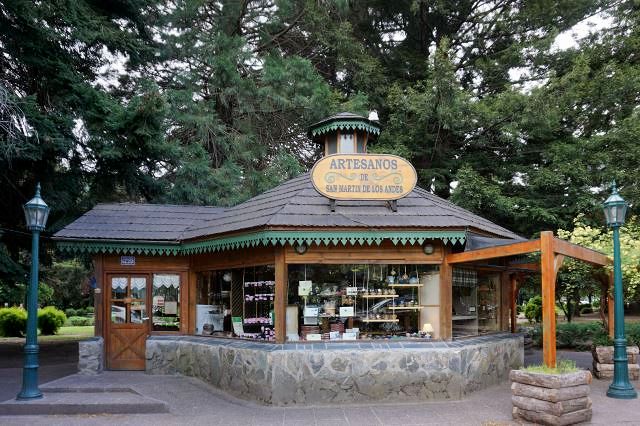
San Martín de los Andes: Gazebo in the park houses a local artisans' store
The town was very attractive and interesting, but I continued my trip. Road 40 passed by a lake and the Lanín National Park started just on the outskirts. The road started ascending to the mountains and I could feel what the demanding ascent, together with the digestion of a gigantic lunch, were doing to my body. In the ascent, the headwind was not expressing itself too strongly, because the hill partially protected me from it.
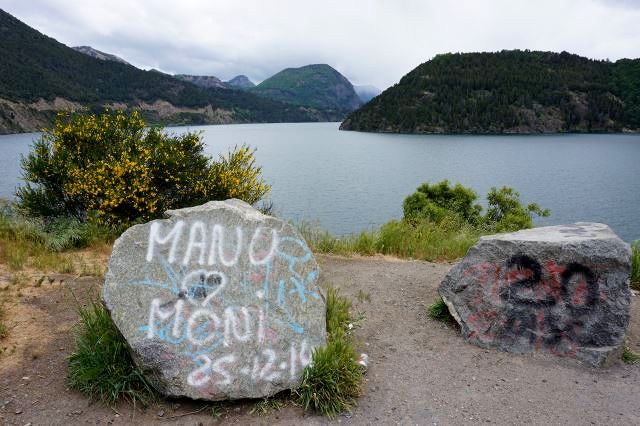
San Martín de los Andes: The lake is already in Lanín National Park
The area certainly deserves the name of The Lake District. I cycled past Lago Frio, Machonico, Hermosa, Falkner, Villarino, Escontido and possibly more. I probably forgot to write down some of the names. Lanín National Park ended and was then directly joined to Nahuel Huapi National Park.

Near San Martín de los Andes: Highway 40 twists around the lake and then continues to pass over the local mountains
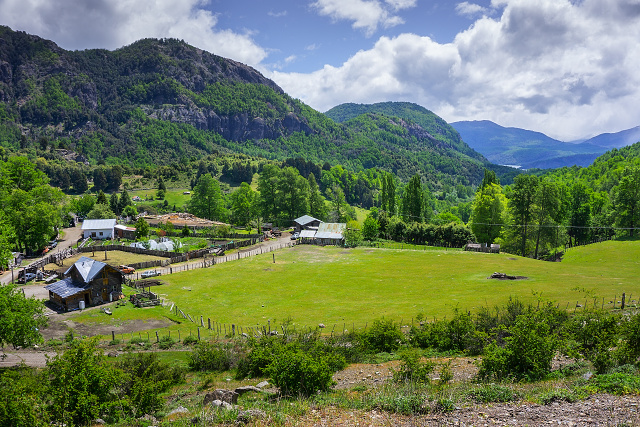
S of San Martín de los Andes: Abundance of water produces an impressive green landscape
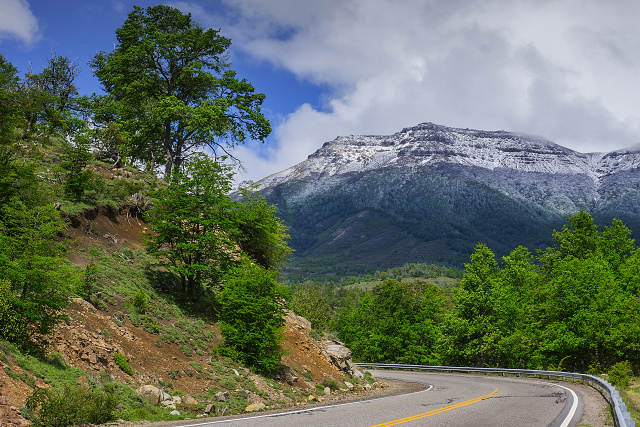
S of San Martín de los Andes: Freshly fallen snow on the mountaintops
I happily reassured myself that accommodation would not be any problem. I passed several campsites and it was possible to pitch my tent in fact anywhere in the forest next to the road. I had cycled my obligatory 100 km and was approaching the Pichi Traful campsite. The exit to this campsite, 2 km away, was via a muddy road. At first, it evidently went steeply uphill, which was why I decided to camp out in the forest beside the road. I was quite cold, so I at least made a cup of coffee, luckily there was enough water around.
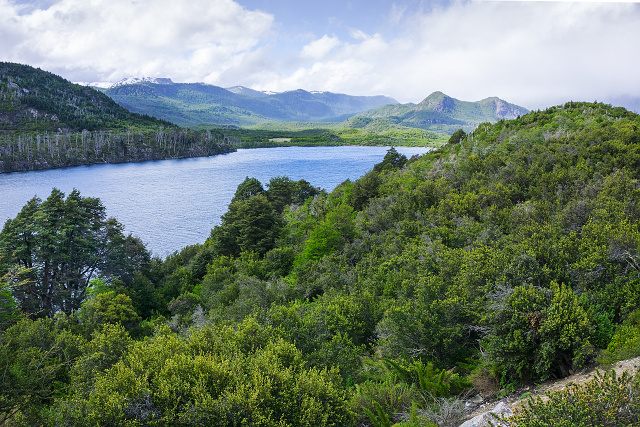
Lago Machonico: One of the many lakes giving the name to this area

Near Lago Hermoso: Capilla San Huberto
During the day, two people recognized the Czech flag on my pannier. One of them was Spanish, so I could understand that he knew it. The second one was a pure-blooded Argentinian who had never been to Europe. Neither was he a Geography teacher, which I immediately asked him. That was the 4th time that year that someone recognized the Czech flag. The first time had been in Uruguay and the second time between Córdoba and Mendoza. The flag was not new, the wind had worn it out so much that it had gained a Swiss, square shape. I take care of it by washing it sometimes, so it does not dishonor our country.
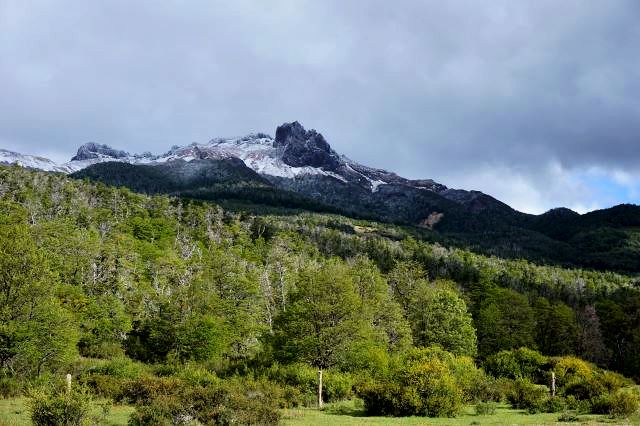
Near Lago Hermoso: Snow-capped mountains contrasting with lush green trees
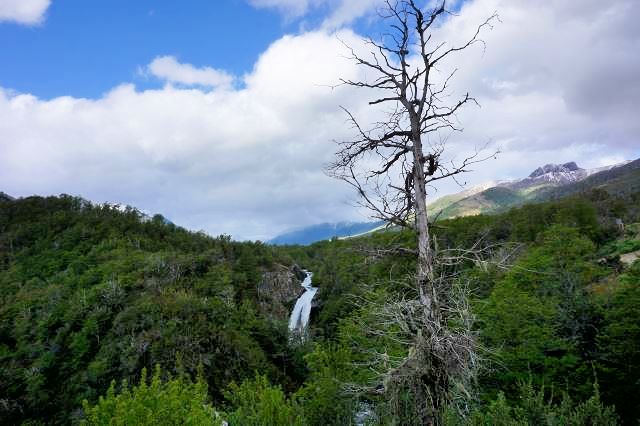
Cascada Vulignanco: The upper part of waterfall approx. 80 m high
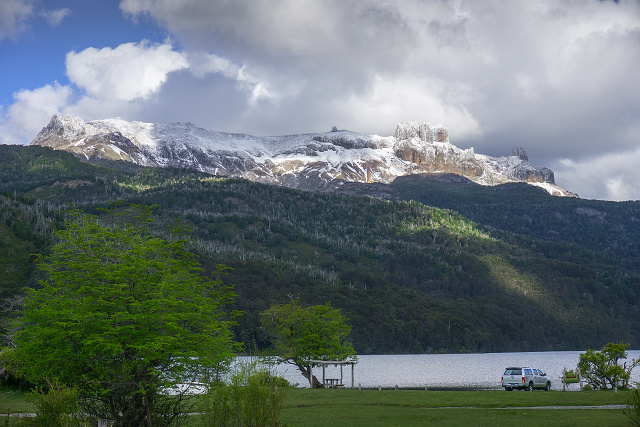
Lago Falkner: Bright snowy rocks jutting out above the lake, in the Nahuel Huapi National Park
Immediately after pitching my tent, light, but intense rain started to fall and continued throughout the night. In the morning, I waited for it to weaken for a short while, packing up my sleeping bag and mattress while still in the tent so they would not get too wet. Then I quickly packed up the wet tent, which I managed to do before the next downpour. I had my breakfast standing up. It was a yogurt with three handfuls of oats, drank some water and by 07:00 was already on the road.

Pichi Traful: Morning awakening in the wet woods
As I reached a higher altitude, the rain started to change into snow. Luckily, the snow immediately melted on the road. My bare fingers were terribly cold and, with tears of pain in my eyes, I thought about my Neoprene gloves which I had purchased from the Japanese army surplus store. I had left them at home in order to save 10 dkg on weight. My hands were so numb that I would not be able to wee, because I could not open the zipper on my trousers.
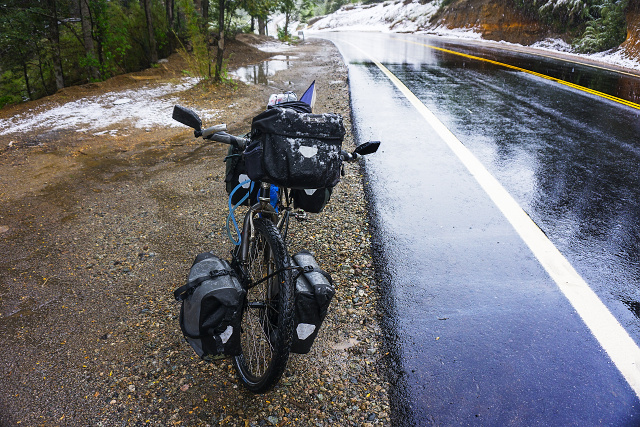
S of Pichi Traful: Wet snow does not please me
I cursed myself for being such an idiot, but it did not help my hands. Then I remembered the smart solution of our grandmothers. I took out the bags for my rain jacket and pants and put them on my hands. I immediately felt better, yet suddenly started to feel my frozen toes more, but that was not as serious. The bags on the hands made gear changing difficult. Especially lifting the lever with my thumb was challenging.
I welcomed the ascents with pleasure, something which would only be appreciated under normal circumstances by masochistic cyclists. They warmed me up. I cycled standing up, which activated and increased the circulation in my toes. I went downhill slowly, the road was wet and slippery. I could not even imagine how I would repair a tire in such weather, should I get a puncture. My stiff hands could not even press the camera shutter button, let alone repair anything.
The bags on my hands were soaked through after 25 km and I was back where I had started. Singing encouraging songs did not help me either, even though I sang hits such as My letci máme ocelové ptáky (We pilots own steel birds), Šel Jeník kolem zahrádky (Jenik walked around the garden), Zvítìzí jenom mladí (Only the young will win) and other inspiring songs. I took off the water-logged cycling gloves and covered my hands with several plastic bags. I certainly looked like a moron, but it helped.
It was a shame about the foul weather, as the vista of lakes was endless. Some of them were not called 'Lago' but 'Laguna'. I could not figure out the difference. The conditions were not right for photography, all a bit too distant, covered in fog and, with the plastic bags on my hands, it would have been difficult to take out the camera and press the shutter button.

San Carlos de Bariloche: I turn my bedroom in Lagos Hotel into a drying room; tent drying in the bathroom
50 km later, I arrived at Villa La Angostura. It was not snowing, instead it was raining, with a sharp freezing headwind. The average temperature on my cyclocomputer between 7:00 and 11:00 was 2 degrees Celsius. As cold as Siberia. I spotted a small bus terminal and decided to travel the remaining 85 km to Bariloche by bus. A bus was just about to leave, I purchased the ticket and the driver was in such a hurry that we pushed my bicycle into the luggage space with all the panniers still attached to it. It was placed lying down, so I only made sure that the gear was facing upwards. The ticket cost 56 pesos but the driver asked me for 50 more pesos for the bicycle (which went into his pocket). I was ready to pay 10x more, considering the situation.
When on the bus, I took off and wrung out my socks, placed them on the heater with my feet and finally started to thaw out. The road passed beside the extensive Nahuel Huapi Lake. I would probably take this road on my way to Chile, so I had not missed anything anyway.
San Carlos de Bariloche
I found accommodation in a hotel in the center of Bariloche, which I had selected on the Internet and which was also notably cheaper than hostels. Bariloche, as they called it for short, was a very expensive area. It was set in beautiful surroundings, with two ski resorts. One could enjoy many nature trails on foot or mountain bike and raft on several rivers. The city is beside the eponymous lake, surrounded by a series of snow-covered mountains. People were wearing winter quilted jackets, many were wearing gloves. The weather was supposedly the same as in mid-winter, yet it was the middle of our May.

San Carlos de Bariloche: View from hotel window
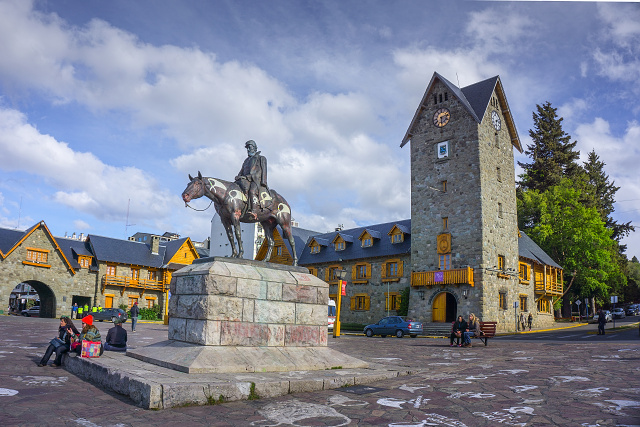
San Carlos de Bariloche: Centro Civico
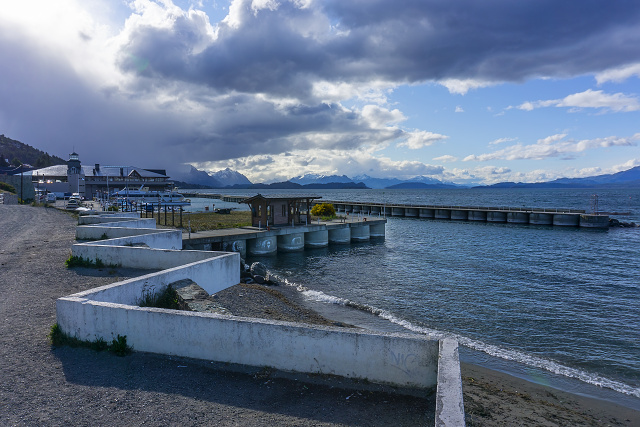
San Carlos de Bariloche: Coast of overwhelmingly large Nahuel Huapi lake
I filled the bathtub with hot water, lay in it and read for half an hour. Probably thanks to that, I avoided getting a cold or runny nose. The room was pleasantly heated to a tropical 25 degrees, so I let everything dry out. I hung up the tent in the bathroom and it dried out completely by the following morning.
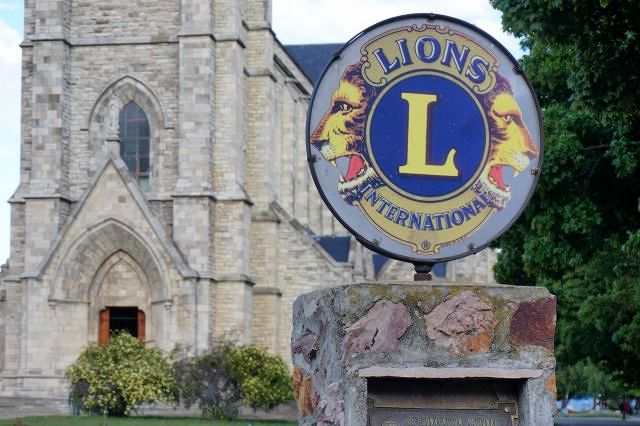
San Carlos de Bariloche: In front of the Cathedral

San Carlos de Bariloche: Interesting wire sculpture in front of Cathedral
In the evening, I went off to buy some gloves. In the North Face branded store, they were selling gloves for the equivalent of Czech CZK 4000 (approx. $200). I skipped those. An old woman was selling leatherette gloves for CZK 250 ($13), I skipped those too, because the leatherette would break up in such cold weather. Finally, I purchased genuine leather insulated gloves for CZK 900 ($45) which would serve me even back home in winter. I needed them, as my hands had suffered frostbite and the distal phalanges were painful. However, they were not red, so it was not serious frostbite, so they would be OK.
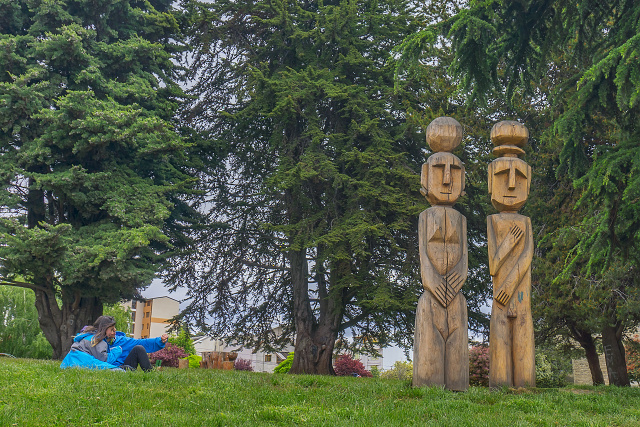
San Carlos de Bariloche: In the park - I could not understand how they could sit on the ground in the cold
The next day, I prescribed a day off for myself. I had a long lie in, then ate a reasonably good hotel breakfast which lasted me until the afternoon. I got my blog up to date, reviewed the previous chapter, answered my e-mails. I glanced over the news in the Czech Republic, it was all the same. Being distanced from it, it was not even worth reading.
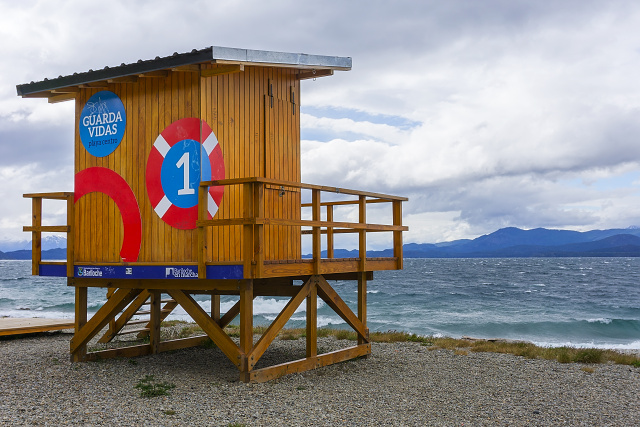
San Carlos de Bariloche: Lifeguards' booth on city beach
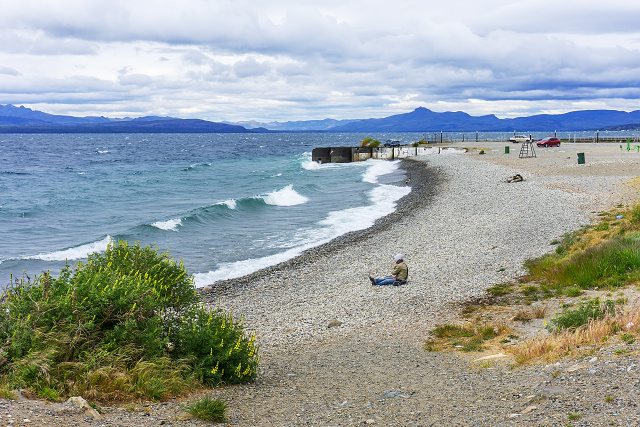
San Carlos de Bariloche: Pebble City Beach
I visited the city, warmly dressed. Shirt, sweater, fleece jacket with hood, headscarf on my head and the new gloves on my hands. It continued being cold and the wind was roaring like mad. I found a solution to my route to Chile. Only one travel agent was offering one-day trips to Puerto Varas, taking tourists through the heart of the Lake District and crossing three lakes by boat. An ordinary tourist paid 2700 pesos. A cyclist would transport himself between the lakes, so the price for cyclists was reduced to 940 pesos (about CZK 2500, $125), not so cheap either. They would not wait for anyone. If the cyclist was delayed, he had to wait till the next day. The boat sailed only once a day.
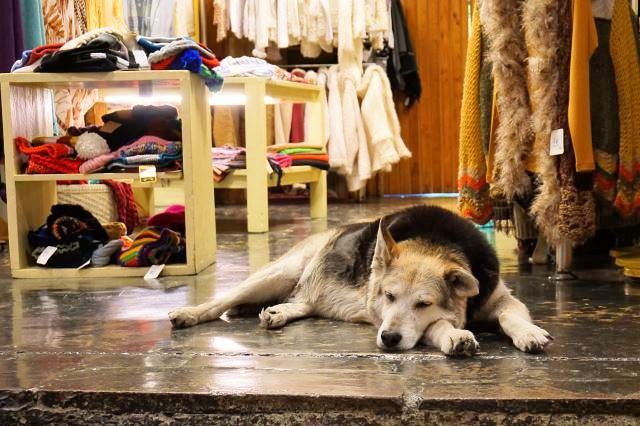
San Carlos de Bariloche: Dog guarding store while the owner chats somewhere else

San Carlos de Bariloche: Chocolate railway at Frantom chocolate factory
That was exactly right for me. I made a reservation for the Saturday and had to pay the fare immediately, otherwise my place would not be guaranteed. They warned me that I had to be in Puerto Panuelo, 25 km from Bariloche, at the latest by 09:30. The route to get there was hilly and, if the weather continued in the same way, it would be right against the wind. Another complication was that one was not allowed to transport any food (meat, fruit or vegetables) into Chile, only manufactured products – conserves. However, packed ham or cheese from a supermarket was also not allowed.

San Carlos de Bariloche: Playground behind Cathedral
I remembered my crossing into Chile four years before, when their search had been thorough. I'd had to take off all my bags and they scanned them. However, they did not scan me, so I managed to get in with some food which was necessary for me in my pockets. And in addition, I could not get hold of Chilean pesos anywhere in Bariloche. I was to live on air until finding an ATM or Exchange office.
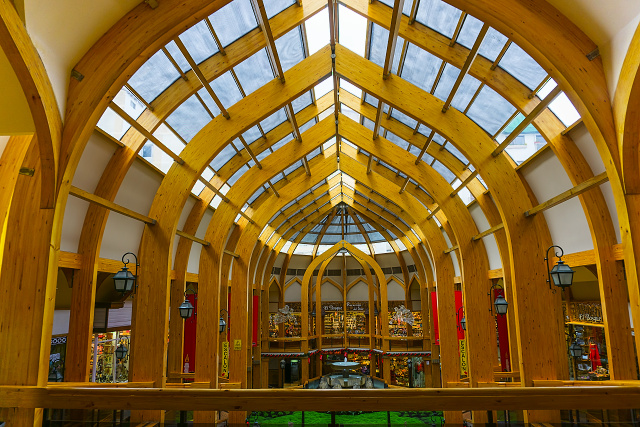
San Carlos de Bariloche: Interior of Galeria del Sur
I paid for another night in the hotel. It was 10% cheaper to pay via hotels.com than directly at the reception. I discussed it with the receptionist, who was very helpful – hotels.com was an American firm and the exchange rate of the same price in Argentinian pesos via dollars was cheaper than if I paid on the spot with my credit card.
Circuite Chico
The weather improved slightly the next day. Despite it raining almost the whole day, the wind dropped slightly and it got a bit warmer. Therefore I went by bicycle to do the "small circuit" – there was no big circuit there. The circuit was 65 km eastwards from Bariloche. I was doubly happy! I had the possibility of measuring the time taken to reach Puerto Panuelo.
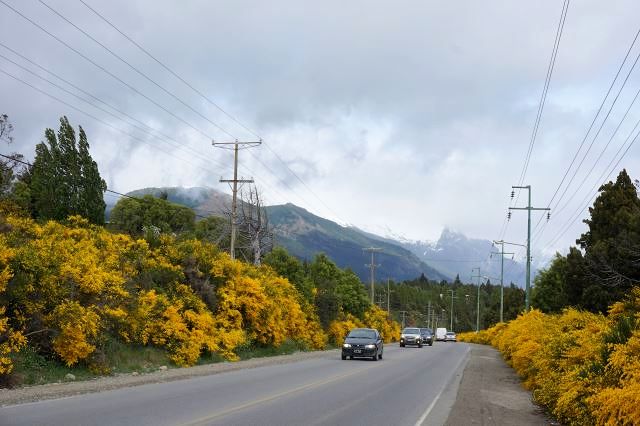
San Carlos de Bariloche: The road is picturesquely lined with flowering shrubs

San Carlos de Bariloche: Cars should keep a distance of at least 1.5 m
The beginning was annoying. A narrow road, no side lane with damaged verges. Very dense traffic and wild drivers, who evidently did not understand how the local wind could move a cyclist. Although the signs repeatedly reminded them to keep a 1.5-meter distance from cyclists, most of them did not respect that. The situation eased about 15 km beyond the city when the traffic got lighter.
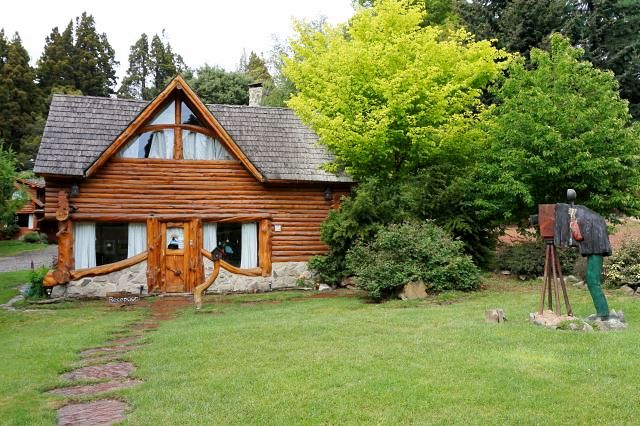
San Carlos de Bariloche: Example of typical traditional building - a combination of wood and stone
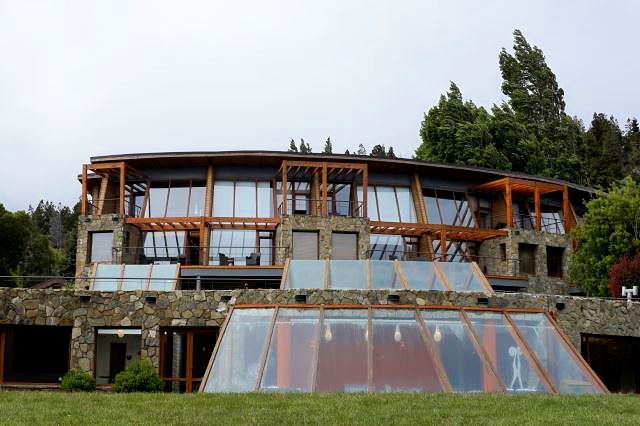
San Carlos de Bariloche: There are also modern styles
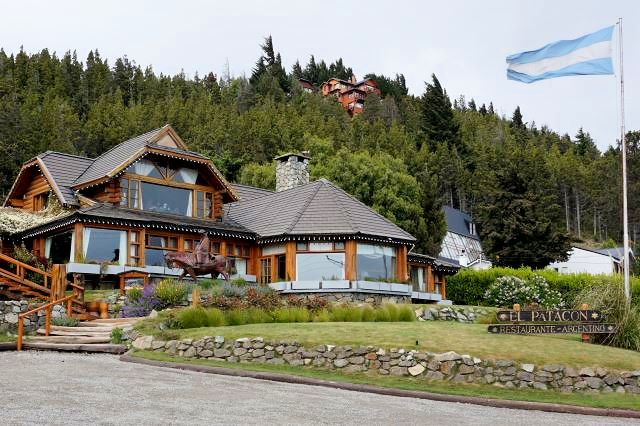
San Carlos de Bariloche: Typical hotel on Nahuel Huapi lakeshore
Even in such a rush, I managed to see the surroundings and to photograph some buildings typical of the region. The lakeshores were mostly built up with hotels. Occasionally, there was a small beer brewery, chocolate factory or store selling local crafts. It took me 1 hour and 45 minutes to the harbor, with frequent stops for photographing. I would reserve 2.5 hours for it the next day, to keep a margin for a strong wind or puncture.

San Carlos de Bariloche: Small Blest brewery, the first in Bariloche, celebrating its 25th anniversary
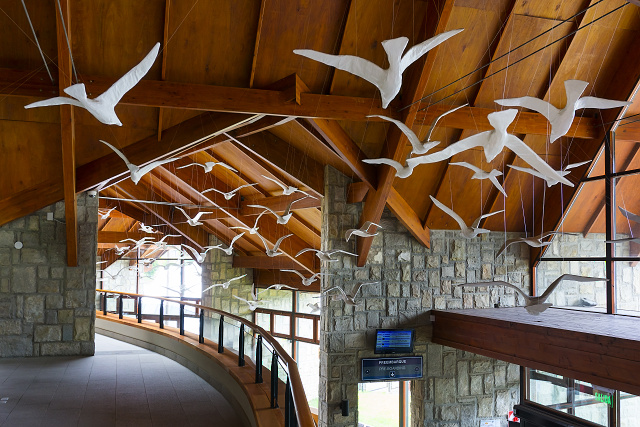
Puerto Paòuelo: Original ceiling decoration at port terminal
Then it was a pure holiday, a pity the weather was so bad. I could imagine the views would be fantastic when the sun was shining and the sky was brightened by fluffy clouds.

Bahía López: The white building of Alun Nehuen Hotel attracts attention in the bay

Bahía López: The beach and pier at Alun Nehuen Hotel
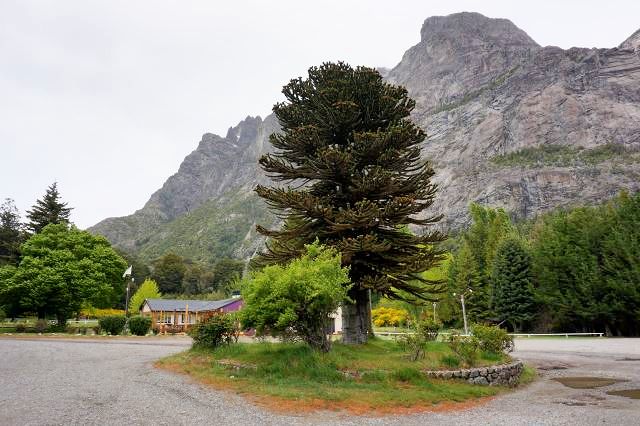
Bahía López: Trees complement the mountain peaks in the background
I adjusted the circuit by visiting Colonia Suiza, a historical village built by Swiss immigrants in the beautiful, rich, verdant landscape on the shores of Lago Perito Moreno Este.

Colonia Suiza: Park entrance

Colonia Suiza: Chapel
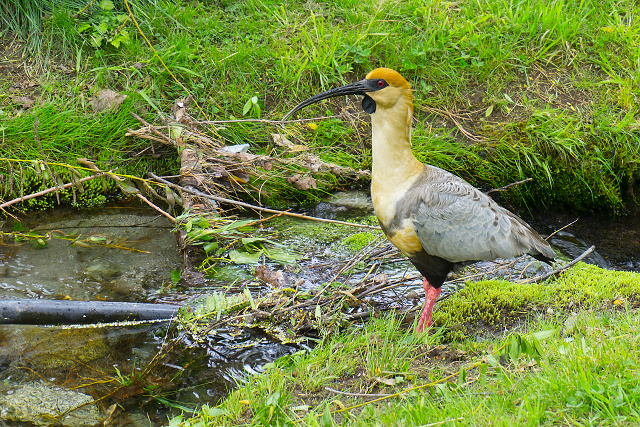
Colonia Suiza: Water bird the size of a duck
As is usually the case, commerce is what spoils it. The village has become a "typical tourist trap," often very cheesy. The disproportionate number of restaurants and stores, often with worthless souvenirs, certainly destroys the atmosphere of the historical center. On such a rainy day, there were only four tourists there, including myself. What a shame for such a beautiful place!
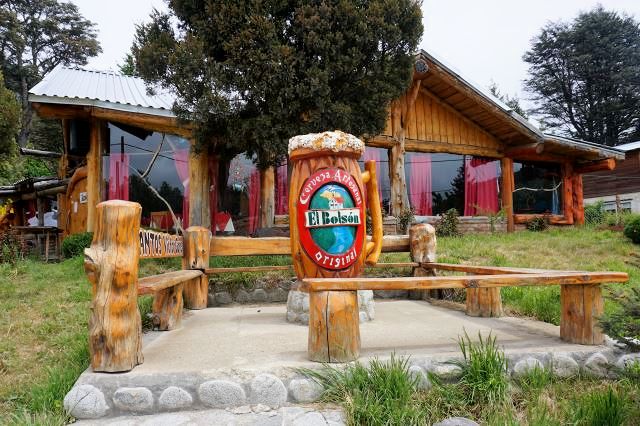
Colonia Suiza: Restaurant with a small brewery

Colonia Suiza: Comedor for tourists, who are intended to relish the food here
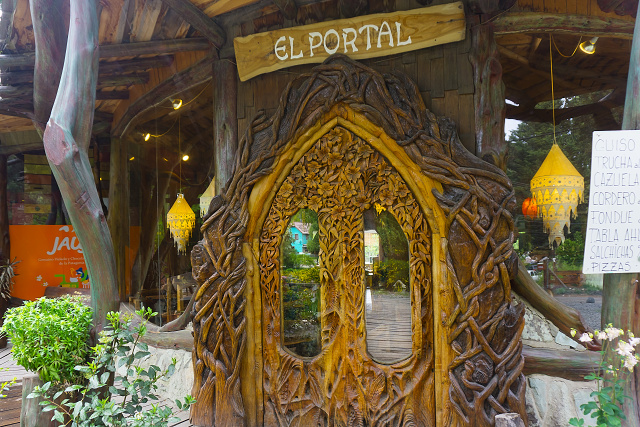
Colonia Suiza: Portal of El Portal restaurant
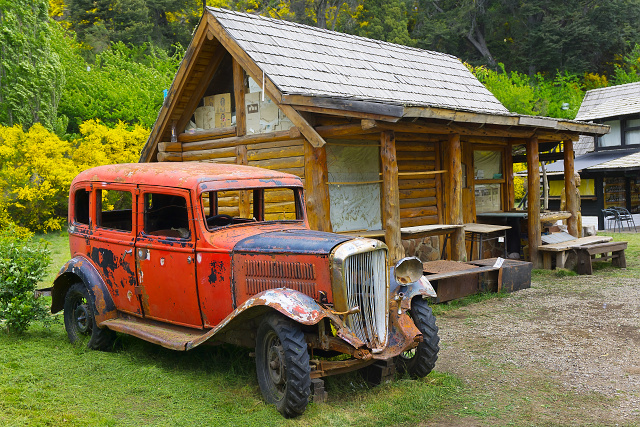
Colonia Suiza: Wreck of 1936 Ford (?) in a group of tourist stores
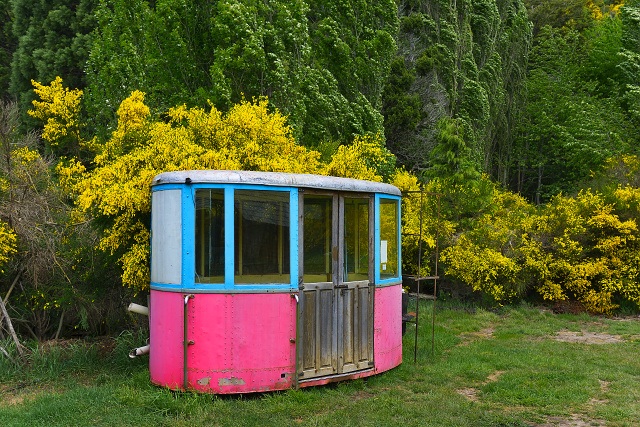
Colonia Suiza: Cabin of historical cableway of unknown origin
I compensated for this with a 10-km ride on an unpaved road along the lakeshore and then through deep forests. I popped up 11 km from Bariloche and then the traffic was bearable. I spent my remaining pesos on food, all of which I consumed as a forethought, keeping 32 pesos for the fee I was to pay at the harbor the next day.






